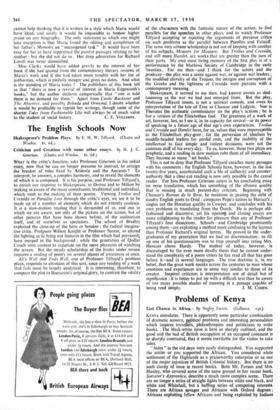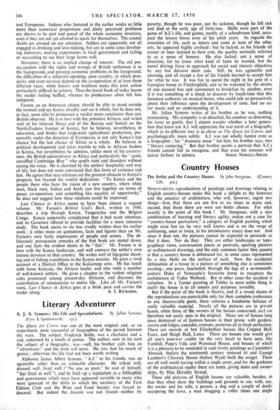Problems of Kenya
Last Chance in Africa. By Negley Farson. (Gollancz. iss.) KENYA stimulates. There is apparently some particular combination of dramatic scenery, gilitical problems and interesting personalities which inspires travd, philanthropists and politicians to write books. The black-white issue is here so sharply outlined, and the good and the bad of British occupation of an occupied continent is so sharply contrasted, that it seems inevitable for the visitor to take sides.
" Sides " in the old days were easily distinguished. You supported the settler or you supported the African. You considered white settlement of the Highlands as a praiseworthy enterprise or as one of the major injustices of British Colonial history. But there is no such clarity of issue in recent books. Both Mr. Farson and Mrs. Huxley, who covered Some of the same ground in her recent book, Sorcerer's Apprentice, describe a much more complex scene. There are no longer a series of straight fights between white and black, and white and Whitehall, but a baffling series of competing interests. There are African savages and Africans with Oxford degrees ; Africans exploiting fellow Africans and being exploited by Indians
and Europeans. Indians who featured in the earlier works as little more than numerical proportions and dimly perceived problems are shown to be part and parcel of the whole economic structure, even if they are not yet allowed to speak for themselves. The coastal Arabs are pressed on our attention. Settlers are apparently not all engaged in drinking and love-nfaking, but are in some cases develop- ing industries, making experiments in local government and failing or succeeding to use their large farms well.
Moreover, there is an implicit change of interest. The old pre- occupation with the rights and wrongs of British settlement is in the background, and pressing economic problems in the foreground, the difficulties of a relatively-speaking, poor country, in which pros- perity and even survival depend on the co-operation of at least three different races, while history and tradition make this joint action particularly difficult to achieve. Thus the travel book of today leaves the reader feeling baffled, whereas its predecessor often left him indignant.
Farson, as an American citizen, should be able to stand outside the turmoil and see Kenya steadily and see it whole, but he does not, in fact, seem able 'to pronounce a verdict more conclusive than any British observer. He is in love with the primitive African, and writes well of his beloved Masai and of the Borana and Somali on the North-Eastern frontier of Kenya, but he believes, nevertheless, in education, and thinks that large-scale agricultural production, pre- sumably under the direction of Europeans, is not only Kenya's last chance but the last chance of Africa as a whole. He believes in political development and takes trouble to talk to African leaders in Kenya, but nevertheless he admires, unlike most of his country- men, the British administrator in Africa and particularly the " quiet; unruffled Cambridge Blue " who quells riots and disorders without raising his voice. He is charmed by the settlers' hospitality and way of life, but does not seem convinced that this form of existence can last. He agrees that race relations are the greatest obstacle to Kenya's progress, but beyond the wistful dedication: " To Kenya and the people there who have the vision of a new country, where white man, black man, Indian and Arab, can live together on terms of peace, co-operation, and something like equality of opportunity," he does not suggest how these relations could be improved.
Last Chance in Africa seems to have been almost a request volume. Mr. Farson's Behind „God's Back, written in 1940, describes a trip through Kenya, Tanganyika and the Belgian Congo. Kenya apparently complained that it had scant attention, and its Governor offered to provide facilities for a more intensive study. The book seems to me less vividly written than his earlier work ; it relies more on quotations, facts and figures than on Mr. Farson's own lively impressions of people and scenes. The de- liberately provocative remarks of the first book are muted down, and one feels the evident desire to be -" fair." Mr. Farson is in love with the Kenya landscape, and well conveys the settler's own intense devotion to that country. He writes well of big-game shoot- ing and of fishing expeditions in the Kenya streams. He gives a vivid account of a District Office in the Kakamega area. He has lunch with Jomo Kenyata, the African leader, and also visits a number of well-known settlers. He gives a chapter to the violent religious cults prominent among present-day Africans, and discusses the contribution of missionaries to native life. Like all Mr. Farson's work, Last Chance in Africa goes at a brisk pace and carries the



































 Previous page
Previous page